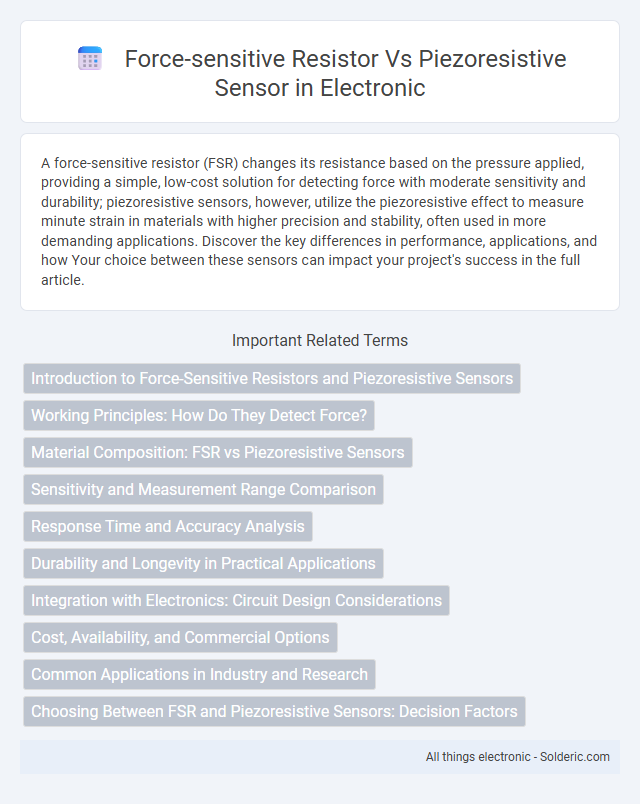A force-sensitive resistor (FSR) changes its resistance based on the pressure applied, providing a simple, low-cost solution for detecting force with moderate sensitivity and durability; piezoresistive sensors, however, utilize the piezoresistive effect to measure minute strain in materials with higher precision and stability, often used in more demanding applications. Discover the key differences in performance, applications, and how Your choice between these sensors can impact your project's success in the full article.
Comparison Table
| Feature | Force-Sensitive Resistor (FSR) | Piezoresistive Sensor |
|---|---|---|
| Operating Principle | Resistance changes with applied force. | Resistance changes due to mechanical strain. |
| Measurement Type | Force or pressure detection. | Stress, strain, or force measurement. |
| Sensitivity | Moderate sensitivity to force. | High sensitivity to strain or stress. |
| Typical Applications | Touch interfaces, robotics, wearable devices. | Structural health monitoring, precision strain gauges. |
| Response Time | Fast, but slower than piezoresistive sensors. | Very fast response time. |
| Durability | Lower durability under repeated stress. | High durability and longevity. |
| Cost | Low cost and easy to integrate. | Generally higher cost due to precision. |
| Linearity | Non-linear response. | More linear output over range. |
Introduction to Force-Sensitive Resistors and Piezoresistive Sensors
Force-sensitive resistors (FSRs) are sensors that change resistance in response to applied force, enabling pressure detection through a flexible polymer substrate embedded with conductive particles. Piezoresistive sensors rely on the piezoresistive effect, where mechanical strain alters the electrical resistance of a semiconductor or metal strain gauge, offering precise measurement of stress, pressure, or force. Both sensors are widely applied in robotics, medical devices, and consumer electronics, with FSRs favored for cost-effectiveness and flexibility, while piezoresistive sensors excel in sensitivity and linearity for high-accuracy applications.
Working Principles: How Do They Detect Force?
Force-sensitive resistors (FSRs) detect force through a change in resistance caused by the compression of a conductive polymer layer, which decreases resistance as pressure increases. Piezoresistive sensors measure force by exploiting the piezoresistive effect, where the electrical resistance of a semiconductor material changes due to applied mechanical stress. Understanding these working principles helps you select the appropriate sensor based on sensitivity, range, and application requirements.
Material Composition: FSR vs Piezoresistive Sensors
Force-sensitive resistors (FSRs) are typically constructed using a polymer thick film comprised of conductive and non-conductive particles, which change resistance under applied force. Piezoresistive sensors consist of semiconductor materials, such as silicon, that alter their electrical resistance due to mechanical stress-induced changes in their crystal lattice structure. Your choice between FSR and piezoresistive sensors should consider the distinct material compositions influencing sensitivity, durability, and response time.
Sensitivity and Measurement Range Comparison
Force-sensitive resistors (FSRs) typically offer high sensitivity at low force levels, making them ideal for detecting light touch or small pressure changes. Piezoresistive sensors generally provide a wider measurement range and greater linearity, allowing accurate force detection across both low and high-pressure conditions. Your choice depends on whether precise low-force sensitivity or a broad, stable measurement range is more critical for your application.
Response Time and Accuracy Analysis
Force-sensitive resistors (FSRs) typically offer faster response times, often in the range of a few milliseconds, making them suitable for applications requiring quick tactile feedback. Piezoresistive sensors generally provide higher accuracy and linearity due to their stable internal resistive changes under stress, enabling precise force measurements. Understanding your application's need for rapid response versus accurate force detection will guide the optimal choice between these sensor types.
Durability and Longevity in Practical Applications
Force-sensitive resistors (FSRs) typically exhibit lower durability and shorter lifespan under repeated stress due to their polymer-based sensing material, which can degrade or lose sensitivity over time. Piezoresistive sensors, made from semiconductor materials, offer greater longevity and robustness with stable performance in harsh environments and high-cycle applications. Their intrinsic material properties enable piezoresistive sensors to maintain accuracy and reliability significantly better than FSRs in continuous or heavy-duty use cases.
Integration with Electronics: Circuit Design Considerations
Force-sensitive resistors (FSRs) require simple voltage divider circuits for integration with electronics, making them suitable for low-cost, low-power applications. Piezoresistive sensors demand more complex signal conditioning, including Wheatstone bridge configurations and amplification to ensure accurate and linear output. Your circuit design must account for these differences to optimize sensitivity, noise reduction, and measurement precision.
Cost, Availability, and Commercial Options
Force-sensitive resistors (FSRs) generally offer lower costs and widespread commercial availability, making them ideal for budget-conscious projects requiring moderate sensitivity. Piezoresistive sensors often come at a higher price point but provide increased precision and durability, with numerous options available from specialized manufacturers. Your choice depends on balancing cost against performance needs, as FSRs suit applications where affordability and ease of sourcing are priorities, while piezoresistive sensors excel in demanding industrial or medical contexts.
Common Applications in Industry and Research
Force-sensitive resistors (FSRs) are widely used in robotics for tactile sensing, wearable devices for pressure monitoring, and industrial automation for load detection due to their flexibility and cost-effectiveness. Piezoresistive sensors find extensive application in precision engineering, structural health monitoring, and biomedical research for accurate strain and pressure measurements, benefiting from their high sensitivity and durability. Both sensors play crucial roles in human-machine interfaces and material testing, with FSRs favored for dynamic pressure sensing and piezoresistive sensors preferred in static or long-term measurement scenarios.
Choosing Between FSR and Piezoresistive Sensors: Decision Factors
When choosing between Force-Sensitive Resistors (FSRs) and piezoresistive sensors, key decision factors include sensitivity, response time, and durability. FSRs offer simplicity and cost-effectiveness with moderate accuracy, while piezoresistive sensors provide higher precision and faster response for dynamic force measurements. Your specific application requirements, such as load range and environmental conditions, will determine the optimal sensor type.
Force-sensitive resistor vs piezoresistive sensor Infographic

 solderic.com
solderic.com